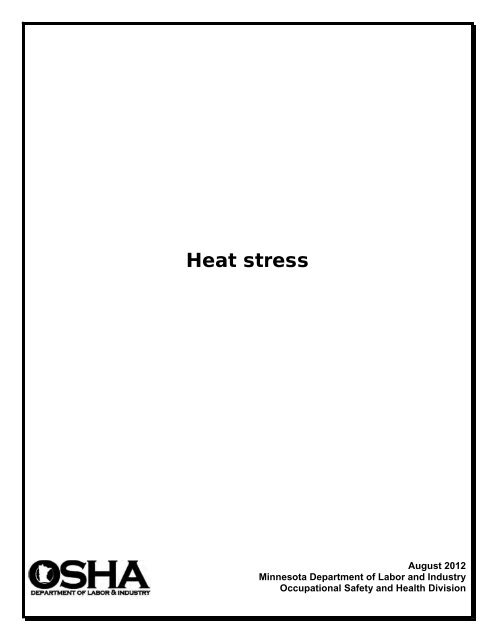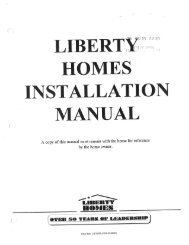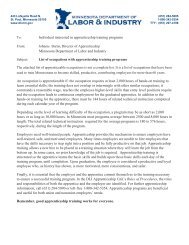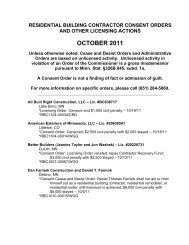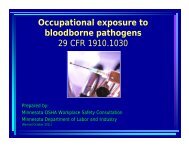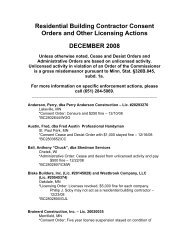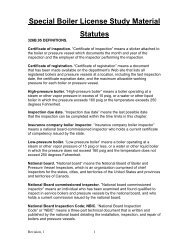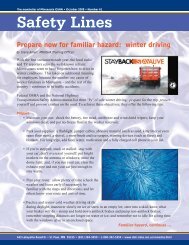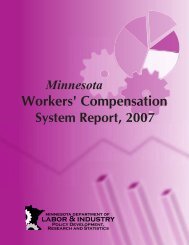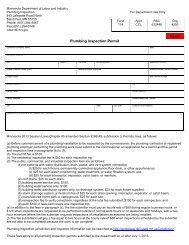Heat stress Guide - Minnesota Department of Labor and Industry
Heat stress Guide - Minnesota Department of Labor and Industry
Heat stress Guide - Minnesota Department of Labor and Industry
You also want an ePaper? Increase the reach of your titles
YUMPU automatically turns print PDFs into web optimized ePapers that Google loves.
<strong>Heat</strong> <strong>stress</strong>August 2012<strong>Minnesota</strong> <strong>Department</strong> <strong>of</strong> <strong>Labor</strong> <strong>and</strong> <strong>Industry</strong>Occupational Safety <strong>and</strong> Health Division
This material can be provided to you in a different format (Braille, large print oraudio) if you call the MNOSHA Training/Outreach Office at (651) 284-5050; at1-877-470- 6742; or via TTY (651) 297-4198.Material contained in this publication is in the public domain <strong>and</strong> may bereproduced, fully or partially, without permission <strong>of</strong> the <strong>Minnesota</strong> <strong>Department</strong> <strong>of</strong><strong>Labor</strong> <strong>and</strong> <strong>Industry</strong> or MNOSHA. Source credit is requested but not required.For more information, contact:<strong>Minnesota</strong> <strong>Department</strong> <strong>of</strong> <strong>Labor</strong> <strong>and</strong> <strong>Industry</strong>Occupational Safety <strong>and</strong> Health Division443 Lafayette Road N.St. Paul, MN 55155-4307Phone: (651) 284-5050Toll-free: 1-877-470-6742Email: osha.compliance@state.mn.usWebsite: www.dli.mn.gov
Table <strong>of</strong> contentsI. Introduction ..........................................................................................................................1II. <strong>Heat</strong> disorders ......................................................................................................................2III. Prevention ............................................................................................................................4IV. Evaluation ............................................................................................................................5V. Control .................................................................................................................................8VI. Training ................................................................................................................................9VII. Additional resources ..........................................................................................................10AppendicesAppendix A ........................................................................................................................11Appendix B ........................................................................................................................13Appendix C ........................................................................................................................14Appendix D ........................................................................................................................15
MNOSHA heat <strong>stress</strong> guideI. Introduction<strong>Heat</strong> <strong>stress</strong> may occur year-round in foundries, kitchens or laundries, or for only a few days during thesummer in almost any work setting.<strong>Heat</strong> <strong>stress</strong> can be as much <strong>of</strong> a problem in <strong>Minnesota</strong> as in other regions <strong>of</strong> the country where hightemperatures are common during the summer. This is because people usually do not have theopportunity to become acclimatized <strong>and</strong> stay acclimatized in climates such as <strong>Minnesota</strong>’s, where dailyhigh temperatures can vary up to 30 degrees from one day to the next during the summer.<strong>Heat</strong> <strong>stress</strong> can result in several illnesses, as well as decreased productivity <strong>and</strong> increased likelihood <strong>of</strong>injuries. <strong>Minnesota</strong>’s heat <strong>stress</strong> st<strong>and</strong>ard is designed to protect employees against the risk <strong>of</strong> heatinducedillnesses <strong>and</strong> unsafe acts.<strong>Heat</strong> <strong>stress</strong> results from a combination <strong>of</strong> internal (body) heat production from doing work <strong>and</strong> externalheat exposure from the environment. Both aspects need to be addressed to properly control heat <strong>stress</strong>.<strong>Minnesota</strong> Rules 5205.0110, subpart 2a, which was revised in July 1997 <strong>and</strong> can be found in AppendixA, is the <strong>Minnesota</strong> OSHA st<strong>and</strong>ard for heat exposure. The st<strong>and</strong>ard is based on the wet bulb globetemperature (WBGT) <strong>and</strong> level <strong>of</strong> work activity. Typically, one will determine the WBGT by using aheat <strong>stress</strong> monitor, or by using a sling psychrometer <strong>and</strong> the nomogram in Appendix B to obtaineffective temperature, then converting effective temperature to WBGT. Appendix C contains someexamples <strong>of</strong> conditions that approximate the limits under the st<strong>and</strong>ard. If the heat <strong>stress</strong> limit isapproached or exceeded, Employee Right-to-Know requirements specified in <strong>Minnesota</strong> Rules5206.0700, subparts 1 <strong>and</strong> 3, Training Program for Harmful Physical Agents, <strong>and</strong> <strong>Minnesota</strong> Rules5206.1100, Labeling Harmful Physical Agents; Label Content, also apply.The following pages contain a discussion <strong>of</strong> heat disorders, prevention <strong>of</strong> disorders, methods forevaluating heat <strong>stress</strong> <strong>and</strong> methods <strong>of</strong> control.MNOSHA heat <strong>stress</strong> guide Page 1 August 2012
II. <strong>Heat</strong> disorders<strong>Heat</strong> strokeSymptoms:Treatment:Cause:Prevention:Usually hot, dry skin; red, mottled or bluish. Sweating may still be present. Confusion,lose <strong>of</strong> consciousness, convulsions. Rapid pulse. Rectal temperature greater than 104ºF.When in doubt, treat as heat stroke. Can be fatal.Medical emergency. Call paramedics <strong>and</strong> start cooling the victim immediately.Remove the victim to a cool area. Soak clothing <strong>and</strong> skin with cool water <strong>and</strong> use a fanto create air movement. Shock may occur. Medical treatment is imperative.Partial or complete failure <strong>of</strong> sweating mechanism. The body cannot get rid <strong>of</strong> excessheat.Acclimatization, close monitoring for signs <strong>of</strong> heat illness, medical screening <strong>and</strong>drinking plenty <strong>of</strong> water.<strong>Heat</strong> exhaustionSymptoms:Treatment:Cause:Prevention:Fatigue, weakness, dizziness, faintness. Nausea, headache. Moist, clammy skin; pale orflushed. Rapid pulse. Normal or slightly elevated temperature.Have the victim rest in a cool area <strong>and</strong> drink fluids.Dehydration causes blood volume to decrease.Acclimatization <strong>and</strong> drinking plenty <strong>of</strong> water.<strong>Heat</strong> syncopeSymptoms:Treatment:Cause:Prevention:Fainting while st<strong>and</strong>ing erect <strong>and</strong> immobile. A variant <strong>of</strong> heat exhaustion. Symptoms <strong>of</strong>heat exhaustion may precede fainting.Move the victim to a cool area, have the victim rest <strong>and</strong> drink fluids.Dehydration causes blood volume to decrease. Blood pools in dilated blood vessels <strong>of</strong>the skin <strong>and</strong> lower body, making less blood available to the brain.Acclimatization, drinking plenty <strong>of</strong> water, avoiding st<strong>and</strong>ing in one place <strong>and</strong>intermittent activity to avoid blood pooling.<strong>Heat</strong> crampsSymptoms:Treatment:Cause:Prevention:Painful muscle spasms in the arms, legs or abdomen during or after hard physical work.Resting, drinking water <strong>and</strong> eating more salty foods.Not well understood. May be due to a loss <strong>of</strong> salt from sweating. Dehydration is afactor.Adequate water intake <strong>and</strong> adequate salt intake at meals; do not use salt tablets.<strong>Heat</strong> rashSymptoms:Treatment:Cause:Prevention:“Prickly heat”; tiny, raised, blister-like rash.Keeping skin clean <strong>and</strong> dry.Skin is constantly wet from sweat. Sweat gl<strong>and</strong> ducts become plugged, leading toinflammation.Showering after working in hot environment. Keeping skin dry.Transient heat fatigueSymptoms:Decline in performance, particularly in skilled physical work, mental tasks <strong>and</strong> thoserequiring concentration.MNOSHA heat <strong>stress</strong> guide Page 2 August 2012
Treatment:Cause:Prevention:No treatment necessary unless other signs <strong>of</strong> heat illness are present.Discomfort. Stress from the heat less than what would result in other heat illnesses.Acclimatization <strong>and</strong> training.Notes: 1. Alcohol, prescription drugs <strong>and</strong> other drugs can increase the possibility <strong>of</strong> heat disordersoccurring, even if used the previous day. 2. <strong>Heat</strong>-related reproductive effects, including reducedfertility <strong>and</strong> increased risk <strong>of</strong> miscarriage, can also occur. A core temperature in the mother above102F can endanger the fetus.MNOSHA heat <strong>stress</strong> guide Page 3 August 2012
III. PreventionThe two most important methods <strong>of</strong> preventing heat disorders are hydration <strong>and</strong> acclimatizationbecause they increase the ability <strong>of</strong> the body to tolerate heat <strong>stress</strong>. Engineering <strong>and</strong> administrativecontrols are important in reducing heat exposure <strong>and</strong> are discussed in Section V.HydrationThe most important factor in preventing heat illnesses is adequate water intake.1. Thirst is not an adequate indicator. Relying on thirst will result in dehydration.2. When the body becomes dehydrated, it is more difficult to rehydrate because the gut does notabsorb water as well. Adequate water intake throughout the day is necessary.3. Workers should drink at least five to seven ounces <strong>of</strong> cool water every 15 to 20 minutes.4. Under conditions <strong>of</strong> pr<strong>of</strong>use sweating, a commercial electrolyte replacement drink may beappropriate. Some drinks are too concentrated <strong>and</strong> need to be diluted or consumed along withwater.5. Salt tablets are to be avoided. Salt tablets irritate the stomach <strong>and</strong> can lead to vomiting, whichresults in further dehydration.AcclimatizationA physiological adaptation will occur with repeated exposure to hot environments. The heart rate willdecrease, sweating will increase, sweat will become more dilute <strong>and</strong> body temperature will be lower.The ability to acclimatize varies among workers. Generally, individuals in good physical conditionacclimatize more rapidly than those in poor condition.Approximately one week <strong>of</strong> gradually increasing the workload <strong>and</strong> time spent in the hot environmentwill usually lead to full acclimatization. On the first day the individual performs 50 percent <strong>of</strong> thenormal workload <strong>and</strong> spends 50 percent <strong>of</strong> the time in the hot environment. Each day an additional 10percent <strong>of</strong> the normal workload <strong>and</strong> time is added, so that by day six, the worker is performing the fullworkload for an entire day. The exposure time should be at least two hours a day for acclimatization tooccur.Acclimatization is lost when exposure to hot environments does not occur for several days. After a oneweek absence, a worker needs to reacclimatize by following a schedule similar to that for initialacclimatization. The acclimatization will occur more rapidly, so increases in workload <strong>and</strong> time canincrease by approximately 20 percent each day after the first day, reaching normal work conditions byday four.MNOSHA heat <strong>stress</strong> guide Page 4 August 2012
IV. EvaluationTwo commonly used instruments to obtain heat <strong>stress</strong> measurements are the heat <strong>stress</strong> monitor <strong>and</strong>the sling psychrometer. The heat <strong>stress</strong> monitor measures several temperatures simultaneously <strong>and</strong>accounts for radiant heat <strong>and</strong> air movement. The sling psychrometer is a less expensive <strong>and</strong> simplerdevice, but does not take into account radiant heat <strong>and</strong> requires that air movement must be determinedseparately.The measurements obtained from either <strong>of</strong> these instruments are converted to one value, the wet bulbglobe temperature (WBGT), for determining compliance with <strong>Minnesota</strong> Rules. WBGT is an index <strong>of</strong>heat <strong>stress</strong> indicating relative comfort. It considers temperature, humidity, radiant heat <strong>and</strong> airmovement. The calculated value can then be compared to these found in <strong>Minnesota</strong> Rules 5205.0110,subpart 2a (Appendix A).<strong>Heat</strong> <strong>stress</strong> monitorThis monitor measures dry-bulb temperature, natural wet-bulb temperature <strong>and</strong> radiant heat, <strong>and</strong> is thepreferred method for determining heat <strong>stress</strong>. The dry-bulb thermometer measures air temperature(T db ). The wet-bulb temperature (T nwb ) accounts for humidity <strong>and</strong> air movement. The globethermometer (T g ) measures heat from radiant energy sources, such as the sun or a furnace, <strong>and</strong> alsoaccounts for air temperature <strong>and</strong> movement. The monitor determines a wet-bulb globe temperature(WBGT) from these measurements using the following equations.For outdoor use in sunshine:WBGT out =0.7(T nwb )+0.2(T g )+0.1(T db ) in F or CFor indoor measurements or outdoor measurements in the shade:WBGT=0.7(T nwb )+0.3(T g ) in F or CFor comparison to the <strong>Minnesota</strong> heat <strong>stress</strong> limits, the indoor WBGT must be used.The monitor should be placed on a flat surface at about the chest height <strong>of</strong> workers in the area. Careshould be taken that the surface chosen has approximately the same temperature as the air.When using a heat <strong>stress</strong> monitor, sufficient time must be allowed for the readings to stabilize. Thiscan take up to 20 minutes if the change in temperature is great.Sling psychrometerThe sling psychrometer measures dry-bulb temperature (T db ) <strong>and</strong> thermodynamic wet-bulb temperature(T wb ). The thermodynamic wet-bulb temperature is not the same as the natural wet-bulb temperatureobtained with a heat <strong>stress</strong> monitor, because the swinging <strong>of</strong> the psychrometer creates a very high rate<strong>of</strong> air movement. A sling psychrometer should not be used if there is heat from a radiant heat source(i.e., hot surfaces) in the area. Use <strong>of</strong> the sling psychrometer under such circumstances would result inan underestimate <strong>of</strong> total heat exposure.MNOSHA heat <strong>stress</strong> guide Page 5 August 2012
workload, the WBGT limit is 86ºF WBGT. For moderate workload, the WBGT limit is 80ºF. Forheavy workload, the WBGT limit is 77ºF.ExampleMeasurements were taken in a food processing plant. One employee was monitored. The workeroperated one machine in the production area <strong>and</strong> took a break in a separate room.No.SamplingperiodTime(min.)AreasampledActivityReadings from heat <strong>stress</strong> monitor(ºF)T g T db T nwb WBGT1 8:00 to 8:30 30 CookerProduct rotation – moderatework98 95 80 852 8:30 to 8:50 20 Cooker Unloading – moderate work 97 90 78 833 8:50 to 9:15 25 Cooker Finishing – moderate work 95 90 78 834 9:15 to 9:30 15 Break room Break 80 78 73 755 9:30 to 10:00 30 Cooker Unloading – moderate work 98 94 80 85T g = globe temperatureT db = dry-bulb temperature (regular thermometer reading)T nwb = natural wet-bulb temperatureA two-hour time-weighted average is then determined:(85)(30) (83)(20) (83)(25) (75)(15) (85)(30) FminWBGT 2hr30 20 25 15 30minWBGT2550 1660 2075 1125 25501202hrWBGT 2hr = 83ºF9960120The two-hour time-weighted average WBGT limit for moderate work is 80ºF, so an overexposure hasoccurred <strong>and</strong> steps must be taken to reduce the heat <strong>stress</strong>.MNOSHA heat <strong>stress</strong> guide Page 7 August 2012
V. ControlIf the heat exposure limit has been exceeded, steps must be taken to reduce the temperature <strong>of</strong> the workenvironment, the time spent in the hot area <strong>and</strong>/or the amount <strong>of</strong> work done.Engineering controls to reduce the workplace temperature may be needed. This may include improvingthe general ventilation, installing local exhaust ventilation to remove heat produced by machinery <strong>and</strong>providing heat shields if radiant heat is a problem. Fans should be used with caution. If the airtemperature is higher than the skin temperature (which is normally about 95F) the heat load on theindividual actually increases.Outside temperature <strong>and</strong> humidity levels should be measured. This information can be useful indetermining the feasibility <strong>of</strong> engineering controls. The information could also be used to predict dayson which heat <strong>stress</strong> will be a problem. If overexposures occur only on unusually hot days, thenengineering controls may not be necessary <strong>and</strong> exposures could be reduced by limiting the time spentin the hot areas.If no breaks in cooler areas occurred during the measuring period, the WBGT should be determined forthe break area so that a work/rest pattern could be developed to reduce heat exposure to an acceptablelevel.Administrative controls can include providing more frequent rest breaks <strong>and</strong>/or longer breaks in coolareas to reduce the two-hour time-weighted average WBGT. However, rest breaks do not necessarilyhave to be in a cooler area. Under extreme conditions, the length <strong>of</strong> the breaks may be longer than thework periods. Worker rotation or assigning more workers to perform the same tasks can reduce theexposure time <strong>and</strong> decrease the physical workload.If other controls are not adequate, personal protective equipment (PPE) should be considered. PPEincludes reflective clothing, ice vests, wetted clothing, <strong>and</strong> air- <strong>and</strong> water-cooled garments. However,PPE used as protection from other hazards, such as respirators <strong>and</strong> totally encapsulating suits, can addto heat <strong>stress</strong> <strong>and</strong> heat strain. (This is also true <strong>of</strong> heavier or multiple layers <strong>of</strong> clothing, whichinterferes with the transfer <strong>of</strong> heat from the body to the air.)The most important measure in reducing heat <strong>stress</strong> is ensuring adequate hydration. Cool water shouldbe readily available in the work area so workers do not need to leave the area to get a drink <strong>of</strong> water.The employer must <strong>stress</strong> the importance <strong>of</strong> drinking water frequently <strong>and</strong> more than thirst indicates.MNOSHA heat <strong>stress</strong> guide Page 8 August 2012
VI. TrainingSupervisors <strong>and</strong> workers who may be exposed to hot environments must receive training about heat<strong>stress</strong>, symptoms <strong>of</strong> heat illnesses <strong>and</strong> treatment. Under <strong>Minnesota</strong>’s Employee Right-to-Know rules(<strong>Minnesota</strong> Rules 5206.0700, subparts 1 <strong>and</strong> 3), employers are required to provide training about thehazards <strong>of</strong> exposure to heat if exposures are expected to approach the limits in the heat <strong>stress</strong> st<strong>and</strong>ard.This training should include:the limits in the heat <strong>stress</strong> st<strong>and</strong>ard;the possible adverse health effects <strong>of</strong> exposure to heat;the symptoms <strong>of</strong> heat-related illnesses;appropriate medical treatment;the known proper conditions for exposure to heat; <strong>and</strong>if appropriate, the name, address <strong>and</strong> phone number <strong>of</strong> the manufacturer <strong>of</strong> equipment creating orcontributing to the risk <strong>of</strong> heat <strong>stress</strong>.This training must be conducted before an employee is exposed to heat approaching the limits in theheat <strong>stress</strong> st<strong>and</strong>ard; refresher training must be conducted at least annually. All training must beconducted at the employer’s expense. Other requirements under Employee Right-to-Know include acomplete written program, the availability <strong>of</strong> a data sheet describing the same information as coveredin the training program <strong>and</strong> signs identifying those areas in the facility where exposures approach thelimits in the heat <strong>stress</strong> st<strong>and</strong>ard.MNOSHA heat <strong>stress</strong> guide Page 9 August 2012
VII. Additional resourcesFederal OSHA’s Campaign to Prevent <strong>Heat</strong> Illness in Outdoor Workers available atwww.osha.gov/SLTC/heatillnessFederal OSHA’s Safety <strong>and</strong> Health Topics: <strong>Heat</strong> Stress available atwww.osha.gov/SLTC/heat<strong>stress</strong>CDC NIOSH Workplace Safety <strong>and</strong> Health Topics: <strong>Heat</strong> Stress available athttp://www.cdc.gov/niosh/topics/heat<strong>stress</strong> (includes Criteria for a recommended st<strong>and</strong>ard ...occupational exposure to hot environments [Rev. Ed.] <strong>and</strong> Working in hot environments)OSHA-NIOSH InfoSheet: Protecting Workers from <strong>Heat</strong> Illness available atwww.cdc.gov/niosh/docs/2011-174/pdfs/2011-174.pdfAmerican Conference <strong>of</strong> Governmental Industrial Hygienists (ACGIH ). 2011 TLVs <strong>and</strong> BEIs Book. Copyright 2011. (See Appendix D).Other materials used in the preparation <strong>of</strong> this documentACGIH . (1982). Industrial ventilation: A manual <strong>of</strong> recommended practice (17th Ed.). Lansing, MI:Author.ACGIH . (1998). Industrial ventilation: A manual <strong>of</strong> recommended practice (23th Ed.). Cincinnati,OH: Author.Ciriello, V. M. & Snook, S. H. (1977). The prediction <strong>of</strong> WBGT from the Botsball. AmericanIndustrial Hygiene Association journal, 38, 264-271.International Organization for St<strong>and</strong>ardization. (1989). ISO 7243 Hot environments – Estimation <strong>of</strong> theheat <strong>stress</strong> on working man, based on the WBGT-index (wet bulb globe temperature (2 nd Ed.). Geneva,Switzerl<strong>and</strong>: Author.Minard, D. (1973). Physiology <strong>of</strong> heat <strong>stress</strong>. In NIOSH, The industrial environment: Its evaluation<strong>and</strong> control (pp. 399-429). Cincinnati, OH: Author.Mutchler, J. E., & Vecchio, J. R. (1977). Empirical relationships among heat <strong>stress</strong> indices in 14 hotindustries. American Industrial Hygiene Association journal, 38, 253-263.OSHA. (1995). <strong>Heat</strong> <strong>stress</strong>. In OSHA , OSHA technical manual (section III: chapter 4). Washington,DC: Author.Ramsey, J. D. & Bernard, T. E. (2000). <strong>Heat</strong> <strong>stress</strong>. In R. L. Harris (Ed.), Patty’s Industrial Hygiene:Vol 2. (5 th ed., pp. 925-984). New York: Wiley.Walters, J. D. (1968). A field assessment <strong>of</strong> a prototype meter for measuring the wet-bulb globethermometerindex. British Journal <strong>of</strong> Industrial Medicine, 25, 235-240.MNOSHA heat <strong>stress</strong> guide Page 10 August 2012
Appendix A: <strong>Minnesota</strong> Rules 5205.0110 — Workroom Ventilation <strong>and</strong>TemperatureSubpart 1. Air. Air shall be provided <strong>and</strong> distributed in all workrooms as required in this code unlessprohibited by process requirements.Outside air shall be provided to all workrooms at the rate <strong>of</strong> 15 cubic feet per minute per person.Air circulated in any workroom shall be supplied through air inlets arranged, located, <strong>and</strong> equipped sothat the workers shall not be subjected to air velocities exceeding 200 feet per minute except underspecial circumstances specified in this code or where approved by the <strong>Department</strong> <strong>of</strong> <strong>Labor</strong> <strong>and</strong><strong>Industry</strong>.Subp. 2. Repealed (6/30/97)Subp. 2a. <strong>Heat</strong> <strong>stress</strong>. The requirements <strong>of</strong> this subpart cover employee exposure to environmentalheat conditions indoors.A. The following definitions apply when assessing <strong>and</strong> controlling health hazards associatedwith extremes in temperature <strong>and</strong> humidity indoors.(1) “Wet bulb globe temperature index” or “WBGT” means a measure <strong>of</strong> the combinedeffect <strong>of</strong> air temperature, air speed, humidity, <strong>and</strong> radiation. WBGT = 0.7T nwb + 0.3T g(2) “Natural wet-bulb temperature” or “T nwb ” means temperature measured by athermometer which has its sensor covered by a wetted cotton wick, exposed to naturalair movement.(3) “Globe temperature” or “T g ” means temperature measured by a thermometer with itssensor inside a matte black globe, exposed to radiant heat, Vernon Globe or equivalent.(4) “Heavy work” means 350 to 500 kcal/hr (kilocalories per hour), for example: heavylifting <strong>and</strong> pushing, shovel work.(5) “Moderate work” means 200 to 350 kcal/hr, for example: walking about with moderatelifting <strong>and</strong> pushing.(6) “Light work” means up to 200 kcal/hr, for example: sitting or st<strong>and</strong>ing performing lighth<strong>and</strong> or arm work.B. Employees shall not be exposed to indoor environmental heat conditions in excess <strong>of</strong> thevalues listed in Table 1. The values in Table 1 apply to fully clothed acclimatized workers.MNOSHA heat <strong>stress</strong> guide Page 11 August 2012
Table 1. Two-hour time-weighted average permissible heat exposure limits.Work activity WBGT, ºFHeavy work 77Moderate work 80Light work 86C. Employees with exposure to heat shall be provided training according to <strong>Minnesota</strong> Rules5206.0700, subparts 1 <strong>and</strong> 3.Subp. 3. Minimum air temperature. Workroom temperatures shall be maintained as follows:A. The minimum air temperature <strong>of</strong> 60 degrees Fahrenheit shall be maintained in all roomswhere work <strong>of</strong> a strenuous nature is performed, unless prohibited by process requirements.B. The minimum air temperature <strong>of</strong> 65 degrees Fahrenheit shall be maintained in all otherworkrooms unless prohibited by process requirements.Subp. 4. Recirculated air. Air from any exhaust system h<strong>and</strong>ling materials listed in Code <strong>of</strong> FederalRegulations, title 29, subpart Z, shall not be recirculated without written permission from the<strong>Department</strong> <strong>of</strong> <strong>Labor</strong> <strong>and</strong> <strong>Industry</strong>.SA: MS s 182.655; 182.657HIST: 12 SR 634, 21 SR 1897MNOSHA heat <strong>stress</strong> guide Page 12 August 2012
Appendix B: Effective temperature chartNote: From Industrial Ventilation: A Manual <strong>of</strong> Recommended Practice (17th ed.) (p. 3-5) by theAmerican Conference <strong>of</strong> Governmental Industrial Hygienists, 1982, Lansing, MI: ACGIH. Copyright1982 by the American Conference <strong>of</strong> Governmental Industrial Hygienists. Reprinted by permission.MNOSHA heat <strong>stress</strong> guide Page 13 August 2012
Appendix C: Examples <strong>of</strong> conditions that correspond to the heat <strong>stress</strong>limits (approximate)Two-hour TWA permissibleheat exposure limitWBGT = 86ºFLight workWork load(Sitting/st<strong>and</strong>ing with lighth<strong>and</strong>/arm work)WBGT = 80ºFModerate work(Walking about with moderatelifting <strong>and</strong> pushing)WBGT = 77ºFHeavy work(E.g., shoveling)No air movement300 fpmPsychrometricPsychrometricRelative Dry bulb wet bulb Dry bulb wet bulbhumidity T dbT wbT dbT wb(%)(ºF)(ºF)(ºF)(ºF)80 90 85 93 8770 92 83 95 8560 94 82 97 8450 97 80 99 8340 100 79 101 8230 104 77 105 7980 84 79 87 8270 86 77 89 8060 87 76 90 7950 89 74 92 7740 92 72 95 7530 94 71 97 7380 80 76 84 8070 82 74 86 7860 84 72 87 7650 85 71 89 7440 87 70 91 7130 90 67 93 69NotesThis method can only be used where no significant radiant heat sources are present.Limits apply only to general industry indoor work performed by acclimatized workers wearingnormal work clothing.When using a sling psychrometer to determine compliance, first measure the wet bulb <strong>and</strong> dry bulbtemperatures <strong>and</strong> estimate the air speed. Using these figures, determine effective temperature (ET)from the nomogram in Appendix B. The following equation can be used to approximate WBGTfrom ET:WBGT = 1.102 ET – 9.1 in degreesFMNOSHA heat <strong>stress</strong> guide Page 14 August 2012
Appendix D: American Conference <strong>of</strong> Governmental Industrial Hygieniststhreshold limit values for heat <strong>stress</strong> <strong>and</strong> heat strainNote: This section is included for those readers interested in a more detailed discussion about heat<strong>stress</strong>. The following is adapted from the American Conference <strong>of</strong> Governmental Industrial Hygienists(ACGIH ® ), 2011 TLVs ® <strong>and</strong> BEIs ® Book, pages 211-220. Copyright 2011. Reprinted with permission.The goal <strong>of</strong> this TLV ® is to maintain body core temperature within + 1°C <strong>of</strong> normal (37°C). Thiscore body temperature range can be exceeded under certain circumstances with selected populations,environmental <strong>and</strong> physiologic monitoring, <strong>and</strong> other controls.More than any other physical agent, the potential health hazards from work in hot environmentsdepends strongly on physiological factors that lead to a range <strong>of</strong> susceptibilities depending on thelevel <strong>of</strong> acclimatization. Therefore, pr<strong>of</strong>essional judgment is <strong>of</strong> particular importance in assessing thelevel <strong>of</strong> heat <strong>stress</strong> <strong>and</strong> physiological heat strain to adequately provide guidance for protecting nearlyall healthy workers with due consideration <strong>of</strong> individual factors <strong>and</strong> the type <strong>of</strong> work. Assessment <strong>of</strong>both heat <strong>stress</strong> <strong>and</strong> heat strain can be used for evaluating the risk to worker safety <strong>and</strong> health. Adecisionmaking process is suggested in Figure 1. The exposure guidance provided in Figures 1 <strong>and</strong> 2<strong>and</strong> in the associated documentation <strong>of</strong> the TLV ® represents conditions under which it is believedthat nearly all heat acclimatized, adequately hydrated, unmedicated, healthy workers may berepeatedly exposed without adverse health effects. The action limit (AL) is similarly protective <strong>of</strong>unacclimatized workers <strong>and</strong> represents conditions for which a heat <strong>stress</strong> management programshould be considered. While not part <strong>of</strong> the TLV ® , elements <strong>of</strong> a heat <strong>stress</strong> management programare <strong>of</strong>fered. The exposure guidance is not a fine line between safe <strong>and</strong> dangerous levels.<strong>Heat</strong> <strong>stress</strong> is the net heat load to which a worker may be exposed from the combined contributions<strong>of</strong> metabolic heat, environmental factors, (i.e., air temperature, humidity, air movement <strong>and</strong> radiantheat) <strong>and</strong> clothing requirements. A mild or moderate heat <strong>stress</strong> may cause discomfort <strong>and</strong> mayadversely affect performance <strong>and</strong> safety, but it is not harmful to health. As the heat <strong>stress</strong> approacheshuman tolerance limits, the risk <strong>of</strong> heat-related disorders increases.<strong>Heat</strong> strain is the overall physiological response resulting from heat <strong>stress</strong>. The physiologicalresponses are dedicated to dissipating excess heat from the body.Acclimatization is a gradual physiological adaptation that improves an individual’s ability to tolerateheat <strong>stress</strong>. Acclimatization requires physical activity under heat-<strong>stress</strong> conditions similar to thoseanticipated for the work. With a recent history <strong>of</strong> heat-<strong>stress</strong> exposures <strong>of</strong> at least two continuoushours (e.g., five <strong>of</strong> the past seven days to 10 <strong>of</strong> 14 days), a worker can be considered acclimatized forthe purposes <strong>of</strong> the TLV ® . Its loss begins when the activity under those heat <strong>stress</strong> conditions isdiscontinued, <strong>and</strong> a noticeable loss occurs after four days <strong>and</strong> may be completely lost in three to fourweeks. Because acclimatization is to the level <strong>of</strong> the heat <strong>stress</strong> exposure, a person will not be fullyacclimatized to a sudden higher level; such as during a heat wave.The decision process illustrated in Figure 1, should be started if:(1) a qualitative exposure assessment indicates the possibility <strong>of</strong> heat <strong>stress</strong>;(2) there are reports <strong>of</strong> discomfort due to heat <strong>stress</strong>; or(3) pr<strong>of</strong>essional judgment indicates heat <strong>stress</strong> conditions.MNOSHA heat <strong>stress</strong> guide Page 15 August 2012
MNOSHA heat <strong>stress</strong> guide Page 16 August 2012
Figure 2. TLV ® (solid line) <strong>and</strong> action limit (broken line) for heat <strong>stress</strong>.WBGT eff is the measured WBGT plus the clothing-adjustment factor.Section 1: Clothing. Ideally, free movement <strong>of</strong> cool, dry air over the skin’s surface maximizes heatremoval by both evaporation <strong>and</strong> convection.Evaporation <strong>of</strong> sweat from the skin is the predominant heat removal mechanism. Water-vaporimpermeable,air-impermeable <strong>and</strong> thermally insulating clothing, as well as encapsulating suits <strong>and</strong>multiple layers <strong>of</strong> clothing, severely restrict heat removal. With heat removal hampered by clothing,metabolic heat may produce excessive heat strain even when ambient conditions are considered cool.Figure 1 requires a decision about clothing <strong>and</strong> how it might affect heat loss. The WBGT-based heatexposure assessment was developed for a traditional work uniform <strong>of</strong> a long-sleeved shirt <strong>and</strong> pants. Ifthe required clothing is adequately described by one <strong>of</strong> the ensembles in Table 1 or by other availabledata, then the “Yes” branch is selected.If workers are required to wear clothing not represented by an ensemble in Table 1, then the “No”branch should be taken. This decision is especially applicable for clothing ensembles that are:1) totally encapsulating suits; or 2) multiple layers where no data are available for adjustments. Forthese kinds <strong>of</strong> ensembles, Table 2 is not a useful screening method to determine a threshold for heat<strong>stress</strong>management actions <strong>and</strong> some risk must be assumed. Unless a detailed analysis methodappropriate to the clothing requirements is available, physiological <strong>and</strong> signs/symptoms monitoringdescribed in Section 4 <strong>and</strong> Table 4 should be followed to assess the exposure.Section 2: Screening threshold based on wet-bulb globe temperature (WBGT). The WBGT <strong>of</strong>fers auseful first order index <strong>of</strong> the environmental contribution to heat <strong>stress</strong>. It is influenced by airtemperature, radiant heat, air movement <strong>and</strong> humidity. As an approximation, it does not fully accountfor all the interactions between a person <strong>and</strong> the environment <strong>and</strong> cannot account for special conditionssuch as heating from a radi<strong>of</strong>requency/microwave source.MNOSHA heat <strong>stress</strong> guide Page 17 August 2012
Table 1. Clothing – Adjustment factors for some clothing ensembles*Clothing type Addition to WBGT [ ○ C]Work clothes (long-sleeved shirt <strong>and</strong> pants) 0Cloth (woven material) coveralls 0Double layer woven clothing 3SMS polypropylene coveralls 0.5Polyolefin coveralls 1Limited-use vapor-barrier coveralls 11*These values must not be used for completely encapsulating suits, <strong>of</strong>ten called Level A. Clothingadjustment factors cannot be added for multiple layers. The coveralls assume that only modesty clothingis worn underneath, not a second layer <strong>of</strong> clothing.WBGT values are calculated using one <strong>of</strong> the following equations:With direct exposure to sunlight:WBGT out = 0.7 T nwb + 0.2T g + 0.1 T dbWithout direct exposure to the sun:WBGT in = 0.7 T nwb + 0.3T gWhereT nwb = natural wet-bulb temperature (sometimes called NWB)T g = globe temperature (sometimes called GT)T db = dry-bulb (air) temperature (sometimes called DB)Because WBGT is only an index <strong>of</strong> the environment, the screening criteria are adjusted for thecontributions <strong>of</strong> work dem<strong>and</strong>s <strong>and</strong> clothing. Table 2 provides WBGT criteria suitable for screeningpurposes. For clothing ensembles listed in Table 1, Table 2 can be used when the clothing adjustmentfactors are added to the environmental WBGT.To determine the degree <strong>of</strong> heat <strong>stress</strong> exposure, the work pattern <strong>and</strong> dem<strong>and</strong>s must be considered. Ifthe work (<strong>and</strong> rest) is distributed over more than one location, then a time-weighted average WBGTshould be used for comparison to Table 2 limits.As metabolic rate increases (i.e., work dem<strong>and</strong>s increase) the criteria values in the table decrease toensure that most workers will not have a core body temperature above 38°C. Correct assessment <strong>of</strong>work rate is <strong>of</strong> equal importance to environmental assessment in evaluating heat <strong>stress</strong>. Table 3provides broad guidance for selecting the work rate category to be used in Table 2. Often there arenatural or prescribed rest breaks within an hour <strong>of</strong> work, <strong>and</strong> Table 2 provides the screening criteria forthree allocations <strong>of</strong> work <strong>and</strong> rest.Based on metabolic rate category for the work <strong>and</strong> the approximate proportion <strong>of</strong> work within an hour,a WBGT criterion can be found in Table 2 for the TLV ® <strong>and</strong> for the action limit. If the measured timeweightedaverage WBGT adjusted for clothing is less than the table value for the action limit, the “No”branch in Figure 1 is taken <strong>and</strong> there is little risk <strong>of</strong> excessive exposures to heat <strong>stress</strong>. If the conditionsare above the action limit, but below the TLV ® , then consider general controls described in Table 5. Ifthere are reports <strong>of</strong> the symptoms <strong>of</strong> heat-related disorders such as fatigue, nausea, dizziness <strong>and</strong>lightheadedness, then the analysis should be reconsidered.MNOSHA heat <strong>stress</strong> guide Page 18 August 2012
Table 2. Screening criteria for TLV ® <strong>and</strong> action limit for heat <strong>stress</strong> exposureAllocation <strong>of</strong> work ina cycle <strong>of</strong> work <strong>and</strong>recoveryTLV ® (WBGT values in °C)Light Moderate Heavy VeryheavyAction limit (WBGT values in °C)Light Moderate Heavy Very heavy75 to 100% 31.0 28.0 - - 28.0 25.0 - -50 to 75% 31.0 29.0 27.5 - 28.5 26.0 24.0 -25 to 50% 32.0 30.0 29.0 28.0 29.5 27.0 25.5 24.50 to 25% 32.5 31.5 30.5 30.0 30.0 29.0 28.0 27.0Notes: See Table 3 <strong>and</strong> Documentation for work dem<strong>and</strong> categories. WBGT values are expressed to the nearest 0.5 °C The thresholds are computed as a TWA-metabolic rate where the metabolic rate for the rest is taken as 115 W <strong>and</strong> work is therepresentative (mid-range) value <strong>of</strong> Table 3. The time base is taken as the proportion <strong>of</strong> work at the upper limit <strong>of</strong> the percent workrange (e.g., 50 percent for the range <strong>of</strong> 25 to 50 percent). If work <strong>and</strong> rest environments are different, hourly time-weighted averages (TWA) WBGT should be calculated <strong>and</strong> used. TWAs forwork rates should also be used when the work dem<strong>and</strong>s vary within the hour, but note that the metabolic rate for rest is alreadyfactored into the screening limit. Values in the table are applied by reference to the “work-rest regimen” section <strong>of</strong> the documentation <strong>and</strong> assume eight-hour workdaysin a five-day workweek with conventional breaks as discussed in the documentation. When workdays are extended, consult theApplication <strong>of</strong> the TLV ® section <strong>of</strong> the documentation. Because <strong>of</strong> the physiological strain associated with heavy <strong>and</strong> very heavy work among less fit workers regardless <strong>of</strong> WBGT, criteriavalues are not provided for continuous work <strong>and</strong> for up to 25 percent rest in an hour for very heavy. The screening criteria are notrecommended <strong>and</strong> a detailed analysis <strong>and</strong>/or physiological monitoring should be used. Table 2 is intended as an initial screening tool to evaluate whether a heat <strong>stress</strong> situation may exist (according to Figure 1) <strong>and</strong>, thus,the table is more protective than the TLV ® or action limit (Figure 2). Because the values are more protective, they are not intended toprescribe work <strong>and</strong> recovery periods.If the work conditions are above the TLV ® screening criteria in Table 2, then a further analysis isrequired following the YES branch.Section 3: Detailed analysis. Table 2 is intended to be used as a screening step. It is possible that acondition may be above the TLV ® or action limit criteria provided in Table 2 <strong>and</strong> still not represent anexposure above the TLV ® or the action limit. To make this determination, a detailed analysis isrequired. Methods are fully described in the documentation, in industrial hygiene <strong>and</strong> safety books,<strong>and</strong> in other sources.Provided that there is adequate information on the heat <strong>stress</strong> effects <strong>of</strong> the required clothing, the firstlevel <strong>of</strong> detailed analysis is a task analysis that includes a time-weighted average <strong>of</strong> the effectiveWBGT (environmental WBGT plus clothing adjustment factor) <strong>and</strong> the metabolic rate. Some clothingadjustment factors have been suggested in Table 1. Factors for other clothing ensembles appearing inthe literature can be used in similar fashion following good pr<strong>of</strong>essional judgment. The TLV ® <strong>and</strong>action limit are shown in Figure 2.MNOSHA heat <strong>stress</strong> guide Page 19 August 2012
Table 3. Metabolic rate categories <strong>and</strong> the representative metabolic rate with example activitiesCategoryMetabolicrate [W]*ExamplesRest 115 SittingLight 180 Sitting with light manual work with h<strong>and</strong>s or h<strong>and</strong>s <strong>and</strong> arms <strong>and</strong> driving. St<strong>and</strong>ingwith some light arm work <strong>and</strong> occasional walking.Moderate 300 Sustained moderate h<strong>and</strong> <strong>and</strong> arm work, moderate arm <strong>and</strong> leg work, moderatearm <strong>and</strong> trunk work, or light pushing <strong>and</strong> pulling. Normal walking.Heavy 415 Intense arm <strong>and</strong> trunk work, carrying, shoveling, manual sawing; pushing <strong>and</strong>pulling heavy loads; <strong>and</strong> walking at a fast pace.Very heavy 520 Very intense activity at fast to maximum pace.*The effect <strong>of</strong> body weight on the estimated metabolic rate can be accounted for by multiplying the estimated rate by the ratio<strong>of</strong> actual body weight divided by 70 kg (154 lb).The second level <strong>of</strong> detailed analysis would follow a rational model <strong>of</strong> heat <strong>stress</strong>, such as theInternational St<strong>and</strong>ards Organization (ISO) Predicted <strong>Heat</strong> Strain (ISO 7933 2004; Malchaire et al.,2001). While a rational method (versus the empirically derived WBGT thresholds) is computationallymore difficult, it permits a better underst<strong>and</strong>ing <strong>of</strong> the sources <strong>of</strong> the heat <strong>stress</strong> <strong>and</strong> is a means toappreciate the benefits <strong>of</strong> proposed modifications in the exposure. Guidance to the ISO method <strong>and</strong>other rational methods is described in the literature.The screening criteria require the minimal set <strong>of</strong> data to make a determination. Detailed analysesrequire more data about the exposures. Following Figure 1, the next question asks about theavailability <strong>of</strong> data for a detailed analysis. If these data are not available, the “No” branch takes theevaluation to physiological monitoring to assess the degree <strong>of</strong> heat strain.If the data for a detailed analysis are available, the next step in Figure 1 is the detailed analysis. If theexposure does not exceed the criteria for the action limit (or unacclimatized workers) for theappropriate detailed analysis (e.g., WBGT analysis, another empirical method or a rational method),then the “No” branch can be taken. If the action limit criteria are exceeded but the criteria for theTLV ® (or acclimatized workers) in the detailed analysis are not exceeded, then implement generalcontrols <strong>and</strong> continue to monitor the conditions. General controls include training for workers <strong>and</strong>supervisors, heat <strong>stress</strong> hygiene practices <strong>and</strong> medical surveillance. If the exposure exceeds the limitsfor acclimatized workers in the detailed analysis, the “Yes” branch leads to physiological monitoringas the only alternative to demonstrate that adequate protection is provided.Section 4: <strong>Heat</strong> strain. The risk <strong>and</strong> severity <strong>of</strong> excessive heat strain will vary widely among people,even under identical heat <strong>stress</strong> conditions. The normal physiological responses to heat <strong>stress</strong> providean opportunity to monitor heat strain among workers <strong>and</strong> to use this information to assess the level <strong>of</strong>heat strain present in the workforce, to control exposures, <strong>and</strong> to assess the effectiveness <strong>of</strong>implemented controls. Table 4 provides guidance for acceptable limits <strong>of</strong> heat strain.MNOSHA heat <strong>stress</strong> guide Page 20 August 2012
Table 4. <strong>Guide</strong>lines for limiting heat strainMonitoring heat strain <strong>and</strong> signs <strong>and</strong> symptoms <strong>of</strong> heat-related disorders is sound industrial hygienepractice, especially when clothing may significantly reduce heat loss. For surveillance purposes, a pattern<strong>of</strong> workers exceeding the heat strain limits is indicative <strong>of</strong> a need to control the exposures. On anindividual basis, the limits represent a time to cease an exposure <strong>and</strong> allow for recovery.One or more <strong>of</strong> the following measures may mark excessive heat strain, <strong>and</strong> an individual's exposure toheat <strong>stress</strong> should be discontinued when any <strong>of</strong> the following occur: sustained (several minutes) heart rate is in excess <strong>of</strong> 180 bpm (beats per minute) minus theindividual's age in years (e.g., 180 - age), for individuals with assessed normal cardiac performance;or body core temperature is greater than 38.5°C (101.3°F) for medically selected <strong>and</strong> acclimatizedpersonnel or greater than 38°C (100.4°F) in unselected, unacclimatized workers; or recovery heart rate at one minute after a peak work effort is greater than 120 bpm; or there are symptoms <strong>of</strong> sudden <strong>and</strong> severe fatigue, nausea, dizziness or lightheadedness.An individual may be at greater risk <strong>of</strong> heat-related disorders if: pr<strong>of</strong>use sweating is sustained over hours; or weight loss over a shift is greater than 1.5 percent <strong>of</strong> body weight; or 24-hour urinary sodium excretion is less than 50 mmoles.Emergency response: If a worker appears to be disoriented or confused, suffers inexplicable irritability,malaise or chills, the worker should be removed for rest in a cool location with rapidly circulating air <strong>and</strong>kept under skilled observation. Absent medical advice to the contrary, treat this as an emergency withimmediate transport to a hospital. An emergency response plan is necessary.– Never ignore anyone's signs or symptoms <strong>of</strong> heat-related disorders. –Following good industrial hygiene sampling practice, which considers likely extremes <strong>and</strong> the lesstolerant workers, the absence <strong>of</strong> any <strong>of</strong> these limiting observations indicates acceptable management <strong>of</strong>the heat <strong>stress</strong> exposures. With acceptable levels <strong>of</strong> heat strain, the “No” branch in Figure 1 is taken.Nevertheless, if the heat strain among workers is considered acceptable at the time, consideration <strong>of</strong>the general controls is recommended. In addition, periodic physiological monitoring should becontinued to ensure acceptable levels <strong>of</strong> heat strain.If limiting heat strain is found during the physiological assessments, then the “Yes” branch is taken.This means that suitable job-specific controls should be implemented to a sufficient extent to controlheat strain. The job-specific controls include engineering controls, administrative controls <strong>and</strong> personalprotection.After implementation <strong>of</strong> the job-specific controls, it is necessary to assess their effectiveness <strong>and</strong> toadjust them as needed.Section 5: <strong>Heat</strong> <strong>stress</strong> management <strong>and</strong> controls. The elements <strong>of</strong> a heat <strong>stress</strong> management programincluding general <strong>and</strong> job-specific controls should be considered in the light <strong>of</strong> local conditions <strong>and</strong> thejudgment <strong>of</strong> the industrial hygienist. The recommendation to initiate a heat <strong>stress</strong> managementprogram is marked by 1) heat <strong>stress</strong> levels that exceed the action limit or 2) work in clothingensembles that limit heat loss. In either case, general controls should be considered (Table 5).<strong>Heat</strong> <strong>stress</strong> hygiene practices are particularly important because they reduce the risk that an individualmay suffer a heat-related disorder. The key elements are fluid replacement, self-determination <strong>of</strong>MNOSHA heat <strong>stress</strong> guide Page 21 August 2012
exposures, health status monitoring, maintenance <strong>of</strong> a healthy lifestyle <strong>and</strong> adjustment <strong>of</strong> expectationsbased on acclimatization state. The hygiene practices require the full cooperation <strong>of</strong> supervision <strong>and</strong>workers.In addition to general controls, appropriate job-specific controls are <strong>of</strong>ten required to provide adequateprotection. During the consideration <strong>of</strong> job-specific controls, Table 2 <strong>and</strong> Figure 2, along with Tables 1<strong>and</strong> 3, provide a framework to appreciate the interactions among acclimatization state, metabolic rate,work-rest cycles <strong>and</strong> clothing. Among administrative controls, Table 4 provides acceptablephysiological <strong>and</strong> signs/symptoms limits. The mix <strong>of</strong> job-specific controls can be selected <strong>and</strong>implemented only after a review <strong>of</strong> the dem<strong>and</strong>s <strong>and</strong> constraints <strong>of</strong> any particular situation. Onceimplemented, their effectiveness must be confirmed <strong>and</strong> the controls maintained.The prime objective <strong>of</strong> heat <strong>stress</strong> management is the prevention <strong>of</strong> heat stroke, which is life-threatening<strong>and</strong> the most serious <strong>of</strong> the heat-related disorders. The heat stroke victim is <strong>of</strong>ten manic, disoriented,confused, delirious or unconscious. The victim’s body core temperature is greater than 40°C (104°F). Ifsigns <strong>of</strong> heat stroke appear, aggressive cooling should be started immediately, <strong>and</strong> emergency care <strong>and</strong>hospitalization are essential. The prompt treatment <strong>of</strong> other heat-related disorders generally results in fullrecovery, but medical advice should be sought for treatment <strong>and</strong> return-to- work protocols. It is worthnoting that the possibility <strong>of</strong> accidents <strong>and</strong> injury increases with the level <strong>of</strong> heat <strong>stress</strong>.Prolonged increases in deep body temperatures <strong>and</strong> chronic exposures to high levels <strong>of</strong> heat <strong>stress</strong> areassociated with other disorders such as temporary infertility (male <strong>and</strong> female), elevated heart rate,sleep disturbance, fatigue <strong>and</strong> irritability. During the first trimester <strong>of</strong> pregnancy, a sustained coretemperature greater than 39°C may endanger the fetus.References(1) International Organization for St<strong>and</strong>ardization (ISO): Ergonomics <strong>of</strong> the thermal environment –Analytical determination <strong>and</strong> interpretation <strong>of</strong> heat <strong>stress</strong> using calculation <strong>of</strong> the predicted heatstrain. ISO 7933:2004. ISO, Geneva (2004).(2) Malchaire J; Piette A; Kampmann B; et al.: Development <strong>and</strong> validation <strong>of</strong> thepredicted heat strain model. Ann Occup Hyg. 45(2):123-135 (2001).MNOSHA heat <strong>stress</strong> guide Page 22 August 2012
Table 5. Elements to consider in establishing a heat <strong>stress</strong> management programMonitor heat <strong>stress</strong> (e.g., WBGT screening criteria in Table 2) <strong>and</strong> heat strain (Table 4) to confirmadequate control.General controls Provide accurate verbal <strong>and</strong> written instructions, annual training programs <strong>and</strong> other informationabout heat <strong>stress</strong> <strong>and</strong> strain Encourage drinking small volumes (approximately one cup) <strong>of</strong> cool, palatable water (or otheracceptable fluid replacement drink) about every 20 minutes Encourage employees to report symptoms <strong>of</strong> heat-related disorders to a supervisor Encourage self-limitation <strong>of</strong> exposures when a supervisor is not present Encourage co-worker observation to detect signs <strong>and</strong> symptoms <strong>of</strong> heat strain in others Counsel <strong>and</strong> monitor those who take medications that may compromise normal cardiovascular,blood pressure, body temperature regulation, renal or sweat gl<strong>and</strong> functions, <strong>and</strong> those who abuseor are recovering from the abuse <strong>of</strong> alcohol or other intoxicants Encourage healthy lifestyles, ideal body weight <strong>and</strong> electrolyte balance Adjust expectations <strong>of</strong> those returning to work after absence from hot exposure situations <strong>and</strong>encourage consumption <strong>of</strong> salty foods (with approval <strong>of</strong> physician if on a salt-restricted diet) Consider pre-placement medical screening to identify those susceptible to systemic heat injury Monitor the heat <strong>stress</strong> conditions <strong>and</strong> reports <strong>of</strong> heat-related disordersJob-specific controls Consider engineering controls that reduce the metabolic rate, provide general air movement, reduceprocess heat <strong>and</strong> water vapor release <strong>and</strong> shield radiant heat sources, among others Consider administrative controls that set acceptable exposure times, allow sufficient recovery <strong>and</strong>limit physiological strain Consider personal protection that is demonstrated effective for the specific work practices <strong>and</strong>conditions at the location– Never ignore anyone's signs or symptoms <strong>of</strong> heat-related disorders. –MNOSHA heat <strong>stress</strong> guide Page 23 August 2012
ACGIH ® statement <strong>of</strong> position regarding the TLVs ® <strong>and</strong> BEls ® (excerpt)ACGlH ® is a not-for-pr<strong>of</strong>it scientific association.ACGlH ® proposes guidelines known as TLVs ® <strong>and</strong> BEls ® for use by industrial hygienists inmaking decisions regarding safe levels <strong>of</strong> exposure to various hazards found in the workplace.ACGlH ® is not a st<strong>and</strong>ards-setting body.Regulatory bodies should view TLVs® <strong>and</strong> BEls ® as an expression <strong>of</strong> scientific opinion.TLVs ® <strong>and</strong> BEls ® are not consensus st<strong>and</strong>ards.ACGlH ® TLVs ® <strong>and</strong> BEls ® are based solely on health factors; there is no consideration given toeconomic or technical feasibility. Regulatory agencies should not assume that it is economicallyor technically feasible to meet established TLVs ® or BEls ® .ACGlH ® believes that TLVs ® <strong>and</strong> BEls ® should not be adopted as st<strong>and</strong>ards without an analysis<strong>of</strong> other factors necessary to make appropriate risk management decisions.TLVs ® <strong>and</strong> BEls ® can provide valuable input into the risk characterization process. Regulatoryagencies dealing with hazards addressed by a TLV ® or BEI ® should review the full writtendocumentation for the numerical TLV ® or BEI ® .ACGIH ® published this statement to assist ACGIH ® members, government regulators <strong>and</strong> industrygroups in underst<strong>and</strong>ing the basis <strong>and</strong> limitations <strong>of</strong> the TLVs ® <strong>and</strong> BEls ® when used in a regulatorycontext. The statement was adopted by the ACGIH ® board <strong>of</strong> directors on March 1, 2002.MNOSHA heat <strong>stress</strong> guide Page 24 August 2012


